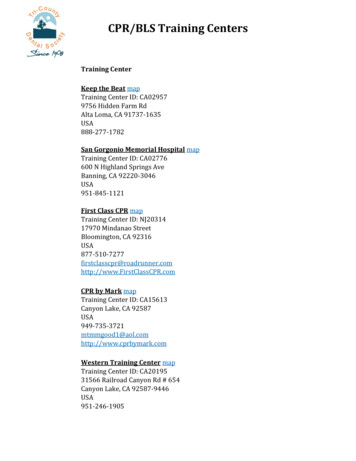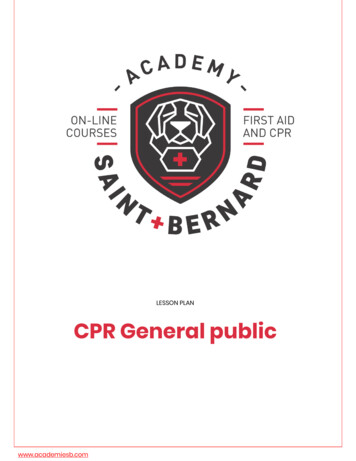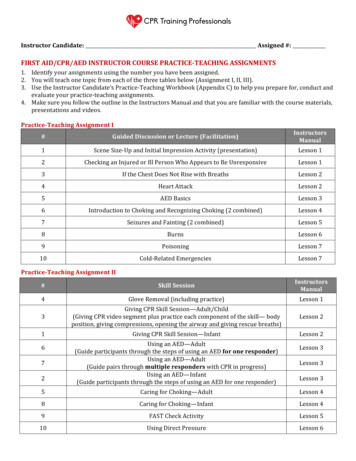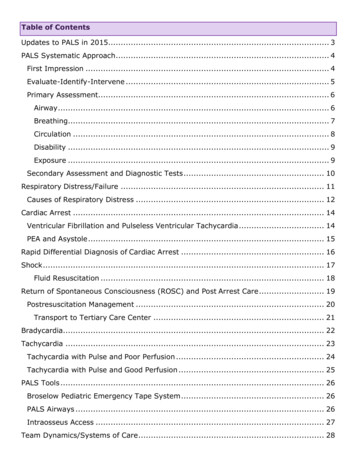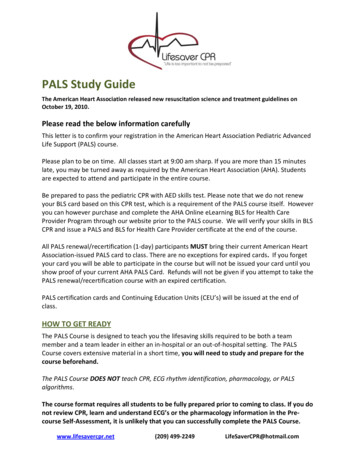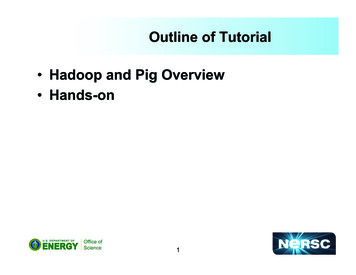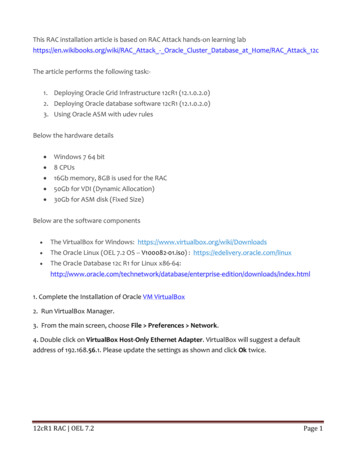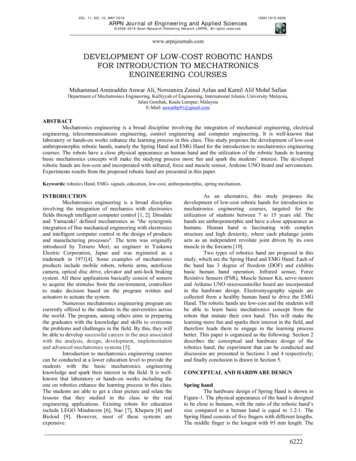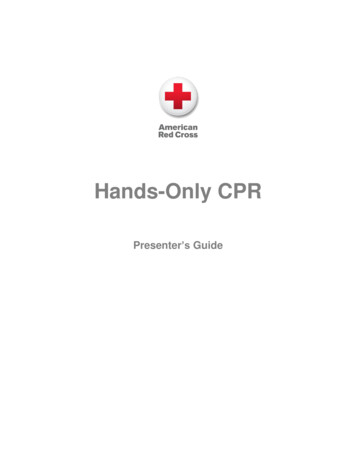
Transcription
Hands-Only CPRPresenter’s Guide
SECTION ACOURSE OVERVIEW ANDPRESENTER INFORMATIONCourse PurposeThe purpose of the American Red Cross Hands-Only CPR course is to teach untrained bystanders howto perform hands-only CPR. Having more bystanders trained in this simple skill can help save lives byputting more cardiac arrest victims within a few steps of lifesaving assistance.Presenter RequirementsCurrently certified American Red Cross First Aid/CPR/AED, Lifeguarding, Emergency MedicalResponse, CPR/AED for Professional Rescuers or Basic Life Support for Healthcare ProvidersInstructors (“CPR Instructors”) are eligible to teach this course after self-orienting to the programmaterials.Persons that are not certified as an instructor in one of the above programs can be trained and certifiedas a Hands-Only CPR Presenter. The 1 hour Hands-Only CPR Presenter Training can be taught by acertified American Red Cross First Aid/CPR/AED, Lifeguarding, Emergency Medical Response,CPR/AED for Professional Rescuers or Basic Life Support for Healthcare Providers Instructor using theHands-Only CPR Presenter Training Course Lesson Plan.Participant PrerequisitesThere are no prerequisites or minimum age to participate in the Hands-Only CPR course.Design and LengthThe Hands-Only CPR course can be taught in approximately 30 minutes. The time is based on apresenter-to-participant ratio of 1:20. The time assumes that each participant has their own manikin orHands-Only CPR compression trainer for skill practice.Materials, Equipment and SuppliesHands-Only CPR Course Presenter’s GuideThe Hands-Only CPR Course Presenter’s Guide helps presenters plan, prepare for and conduct thiscourse. It includes administrative information, a lesson plan and presenter resources.Hands-Only CPR Ready ReferenceEach participant should receive a copy of the Hands-Only CPR Ready Reference. It is a one-pagereference that provides step-by-step instructions with photographs for performing hands-only CPR foruse during and after the course. The Hands-Only CPR Ready Reference is available in both Englishand Spanish language formats.Hands-Only CPR Course PresentationThis Adobe Presenter file has six slides that reinforce talking points. The How to Perform Hands-OnlyCPR Video and the metronome are also built into the presentation and will play using Adobe AcrobatReader. This course presentation is available in both English and Spanish formats.March 6, 20181
How to Perform Hands-Only CPR Video SegmentThe How to Perform Hands-Only CPR video segment is approximately 2 minutes long and providesparticipants with a standardized demonstration of the hands-only skill. The video segment isavailable in both English and Spanish language formats.MetronomePresenters are encouraged to use a metronome during skill practice to help participants practicecompressions at the correct rate of speed (about 106 beats per minute).Hands-Only CPR Compression TrainerParticipants in this course need to be able to simulate chest compressions using either the HandsOnly CPR Compression Trainer or a manikin. The trainer must be used in courses led by non-CPRinstructors. The trainer provides an easy, inexpensive way for participants to practice hands-onlyCPR. The trainer, which is in the shape of an ambulance, is made out of a sponge-like materialengineered to allow the user to simulate compressing a chest to a 2-inch depth. When practicing,participants place the trainer on a hand placement diagram. While not required, those offering thecourse are encouraged to provide each participant with a trainer to take home for additional practiceafter the course.If available, CPR instructors have the option of using manikins instead of the trainer. Instructors mustfollow the same health precautions and guidelines and manikin decontamination guidelines as usedin other first aid, CPR and AED courses."I Learned To Save A Life" StickerThe “I Learned to Save a Life” sticker is an optional item that can be given to participants at the endof the course to reinforce that they are now prepared to save a life.American Red Cross IdentificationAs representatives of the American Red Cross, presenters should wear appropriate identification.Banners, posters and name tags or name tents with the Red Cross logo should also be used duringthe course to help identify the American Red Cross as the training agencyCertification RequirementsThis course has no formal knowledge or skill assessments; therefore, there are no requirements forsuccessful completion. There is no certificate for this course. Instead, participants may be given the "ILearned to Save A Life" sticker upon completion of the course.Presenter ResponsibilitiesYour responsibilities as a presenter when conducting the American Red Cross Hands-Only CPR courseare to: Provide for the health and safety of participants by always ensuring the classroom is free ofhazards. Be familiar with the course materials and audiovisual equipment, and know how to use themeffectively. Be familiar with Red Cross services and be able to provide participants with information onadditional training opportunities and services offered by the Red Cross. Create a non-threatening environment that encourages participants to achieve the learningobjectives. Adapt your teaching approach to match the experience and abilities of the participants. Be prepared to answer participants’ questions or know where to find the answers.March 6, 20182
Submit a completed Hands-Only CPR activity report or use the designated online reporting tool tothe sponsoring Red Cross unit within established timeframes.Red Cross ResponsibilitiesThe Red Cross unit is responsible for providing the highest level of customer service. They do this by: Providing the presenter with evaluation and appropriate reporting forms. Communicating with presenters about new programs and volunteer opportunities. Providing administrative support. Maintaining a current Authorized Provider Agreement if applicable. Having needed materials and equipment available in a timely manner.Reporting ResponsibilitiesSubmit a completed Hands-Only CPR activity report or use the designated online reporting tool to thesponsoring Red Cross unit with established timeframes.March 6, 20183
COURSE LESSON PLANSECTION BCourse Length: 30 minutesCOURSE OBJECTIVESAfter completing this course, participants will be able to: Describe when and how to perform hands-only CPR. Demonstrate how to perform hands-only CPR.MATERIALS, EQUIPMENT AND SUPPLIES Hands-Only CPR Compression Device or adult CPR Manikin (one for each participant)Hands-Only CPR Ready Reference sheet (one for each participant)Disposable latex-free gloves (two for each participant, encouraged but not required)Instruction KeyDiscussionLectureSkill PracticeVideoTOPIC: INTRODUCTIONHANDS-ONLY CPRINSTRUCTION: Introduce yourself and have participants introduce themselves. Review any facility policies and procedures as well as the location of theAED, first aid kits and emergency exits as appropriate. Tell participants that the purpose of this course is to teach bystandershow to perform hands-only CPR.WHAT IS HANDS-ONLY CPR?INSTRUCTION: Hands-only CPR involves calling 9-1-1 or the designated emergencyREFERENCE:Slide 1March 6, 2018number and then giving continuous chest compressions. It onlytakes minutes to learn. Hands-only CPR should be used when you see someone suddenlycollapse and the person is unresponsive and not breathingnormally.4
Having more bystanders trained in this simple skill can help savelives by putting more cardiac arrest victims within a few steps oflifesaving assistance. The Red Cross encourages people who learn this skill to stepforward and take action if they witness the collapse of a person andthat person needs CPR. Learning full CPR is also important. Getting trained in full CPR—combinations of chest compressions and rescue breaths—willenable you to help in other emergencies, like drowning or choking.Full CPR is the best care for all ages, and especially for people whoare more likely to experience respiratory emergencies than cardiacones such as children and infants.TOPIC: PERFORMING HANDS-ONLY CPRSKILL OVERVIEWINSTRUCTION: Show the video segment “How to Perform Hands-Only CPR” (1:42). Answer participants’ questions.REFERENCE:Slide 2HAND AND BODY POSITIONINGINSTRUCTION: Explain the following key points about hand positioning:Place the heel of one hand in the center of the person’s chest.Place the other hand on top of your first hand and interlace yourfingers.o Hold the fingers of your bottom hand up so that your fingers arenot on the person’s chest. Explain the following key points about body positioning:o Position your body so that your shoulders are directly over yourhands. This will let you push on the chest using a straight upand-down motion, which moves the most blood with each pushand is also less tiring.o Keep your arms straight and push down at least 2 inches, andthen let the chest completely return to its normal position.o Push hard and push fast! You want to give chest compressionsat a rate of 100–120 compressions per minute.o Maintain a smooth, steady down-and-up rhythm and do notpause between compressions.ooREFERENCE:Slide 3SKILL PRACTICEINSTRUCTION: Guide participants through the steps of the skill using the Hands-OnlyCPR Ready Reference.March 6, 20185
REFERENCE:Slide 4 Have participants practice the skill independently for about 1 minute.During practice, move around the room to provide corrective feedbackand encouragement to participants.o If available, use a metronome (set to approximately 108 beats perminute) to help participants practice at the correct rate.o If available, encourage participants to wear latex-free gloves. Answer participants’ questions after their first round of practice. Have participants practice the skill a second time for about 1 minute.o Continue to provide corrective and positive feedback to participantsthrough the independent skill practice.TOPIC: CLOSINGCLOSINGINSTRUCTION: Thank participants for their efforts during class and ask for any remaining REFERENCE:Slide 5 questions.Optional: Give participants an “I Learned How to Save A Life Today”sticker.Encourage participants to get trained and certified in full CPR and first aidso they can be prepared to help in other types of emergencies.Participants can find and register for a first aid and CPR/AED class byvisiting redcross.org or by calling 1-800-RED-CROSS.Encourage participants to download the American Red Cross First Aidand Emergency Mobile Apps for free on their iOS and/or Android devicesTurn in the completed Hands-Only CPR activity report or enter thetraining into the online reporting tool for your sponsoring Red Cross unit.Frequently Asked QuestionsThe answers to commonly asked questions are provided below to help you answer participantquestions that may come up during the course.Who should learn hands-only CPR versus full CPR?Everyone should learn at least hands-only CPR. Anyone can learn full CPR. Full CPR isespecially important if you are a workplace responder; live or play around water or have aresidential pool/hot tub; have children or work with children; or have a job-related duty torespond.What if the person is face-down?If the person is face-down, check for responsiveness and normal breathing. If unresponsiveand there is no normal breathing, call or have someone else call 9-1-1 or the designatedemergency number and roll the person onto their back and begin performing CPR with chestcompressions.March 6, 20186
What are agonal gasps?Isolated or infrequent gasping in the absence of other breathing in an unresponsive personmay be agonal gasps which can occur after the heart has stopped beating. Agonal gasps arenot normal breathing. Since reducing time without chest compressions is so important,rescuers should decide in favor of doing chest compressions if there is any doubt if a victim isbreathing normally.Should I check for severe, life-threatening bleeding?Truly severe, life-threatening bleeding will be evident when the rescuer approaches the victim.Control the bleeding with any available resources and then prepare to perform CPR if theperson is unresponsive and has no normal breathing.What if I am alone?In general, if someone suddenly collapses and is unresponsive and you are alone, first call 91-1 or the designated emergency number. Using the speaker mode of a mobile phone willallow you to care for the person while alerting emergency responders. It is important to ensurehelp is on the way. There are many things that may influence the decision, such as age of thevictim, proximity of an AED and distance to a telephone.What if the person vomits?If at any time the person vomits, quickly roll the person onto their side, supporting the headand neck and rolling the body as a unit to the best of your ability. After vomiting stops, wipe theperson’s mouth out using a finger sweep. Roll the person onto their back and continue givingcare. Wear latex-free disposable gloves whenever possible.Can I use hands-only CPR for a child or infant?Hands-only CPR is primarily used for adults who you see suddenly collapse. Full CPRincluding compressions and ventilations is the best emergency care for a child or infant who isunresponsive and not breathing normally, but if untrained, unwilling or unable to provideventilations calling 9-1-1 and giving chest compressions is better than doing nothing.Would I push as hard when giving chest compressions to a child or infant?This course teaches a compression depth of at least 2 inches because most sudden cardiacarrest victims will be adults or adolescents. You would compress the chest slightly less, about2 inches for a child and about 1 ½ inches for an infant (for infants use the pads of two fingersjust below the nipple line in the center of the chest). Most people do not push hard enougheven for children and infants so always remember to
Hands-Only CPR Presenter Training Course Lesson Plan. Participant Prerequisites There are no prerequisites or minimum age to participate in the Hands-Only CPR course. Design and Length The Hands-Only CPR course can be taught in approximately 30 minutes. The time is based on a presenter-to-participant ratio of 1:20. The time assumes that each participant has their own manikin or Hands-Only CPR .
